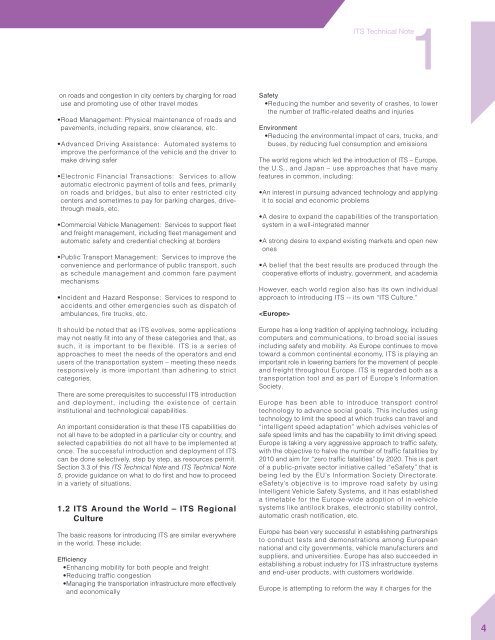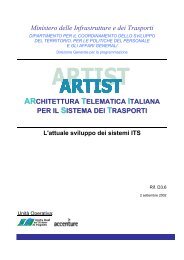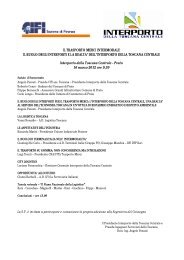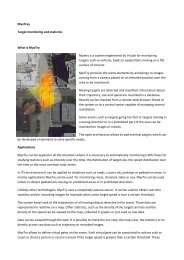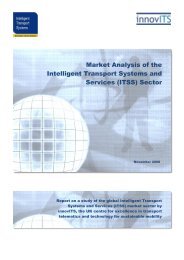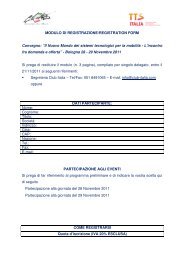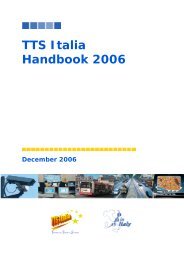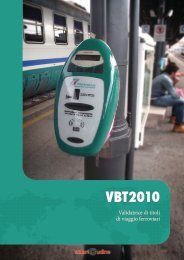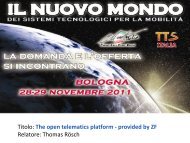ITS for Developing Countries ITS for Developing Countries - TTS Italia
ITS for Developing Countries ITS for Developing Countries - TTS Italia
ITS for Developing Countries ITS for Developing Countries - TTS Italia
You also want an ePaper? Increase the reach of your titles
YUMPU automatically turns print PDFs into web optimized ePapers that Google loves.
1<br />
<strong>ITS</strong> Technical Note<br />
on roads and congestion in city centers by charging <strong>for</strong> road<br />
use and promoting use of other travel modes<br />
•Road Management: Physical maintenance of roads and<br />
pavements, including repairs, snow clearance, etc.<br />
•Advanced Driving Assistance: Automated systems to<br />
improve the per<strong>for</strong>mance of the vehicle and the driver to<br />
make driving safer<br />
•Electronic Financial Transactions: Services to allow<br />
automatic electronic payment of tolls and fees, primarily<br />
on roads and bridges, but also to enter restricted city<br />
centers and sometimes to pay <strong>for</strong> parking charges, drivethrough<br />
meals, etc.<br />
•Commercial Vehicle Management: Services to support fleet<br />
and freight management, including fleet management and<br />
automatic safety and credential checking at borders<br />
•Public Transport Management: Services to improve the<br />
convenience and per<strong>for</strong>mance of public transport, such<br />
as schedule management and common fare payment<br />
mechanisms<br />
•Incident and Hazard Response: Services to respond to<br />
accidents and other emergencies such as dispatch of<br />
ambulances, fire trucks, etc.<br />
It should be noted that as <strong>ITS</strong> evolves, some applications<br />
may not neatly fit into any of these categories and that, as<br />
such, it is important to be flexible. <strong>ITS</strong> is a series of<br />
approaches to meet the needs of the operators and end<br />
users of the transportation system – meeting these needs<br />
responsively is more important than adhering to strict<br />
categories.<br />
There are some prerequisites to successful <strong>ITS</strong> introduction<br />
and deployment, including the existence of certain<br />
institutional and technological capabilities.<br />
An important consideration is that these <strong>ITS</strong> capabilities do<br />
not all have to be adopted in a particular city or country, and<br />
selected capabilities do not all have to be implemented at<br />
once. The successful introduction and deployment of <strong>ITS</strong><br />
can be done selectively, step by step, as resources permit.<br />
Section 3.3 of this <strong>ITS</strong> Technical Note and <strong>ITS</strong> Technical Note<br />
5, provide guidance on what to do first and how to proceed<br />
in a variety of situations.<br />
1.2 <strong>ITS</strong> Around the World – <strong>ITS</strong> Regional<br />
Culture<br />
The basic reasons <strong>for</strong> introducing <strong>ITS</strong> are similar everywhere<br />
in the world. These include:<br />
Efficiency<br />
•Enhancing mobility <strong>for</strong> both people and freight<br />
•Reducing traffic congestion<br />
•Managing the transportation infrastructure more effectively<br />
and economically<br />
Safety<br />
•Reducing the number and severity of crashes, to lower<br />
the number of traffic-related deaths and injuries<br />
Environment<br />
•Reducing the environmental impact of cars, trucks, and<br />
buses, by reducing fuel consumption and emissions<br />
The world regions which led the introduction of <strong>ITS</strong> – Europe,<br />
the U.S., and Japan – use approaches that have many<br />
features in common, including:<br />
•An interest in pursuing advanced technology and applying<br />
it to social and economic problems<br />
•A desire to expand the capabilities of the transportation<br />
system in a well-integrated manner<br />
•A strong desire to expand existing markets and open new<br />
ones<br />
•A belief that the best results are produced through the<br />
cooperative ef<strong>for</strong>ts of industry, government, and academia<br />
However, each world region also has its own individual<br />
approach to introducing <strong>ITS</strong> -- its own “<strong>ITS</strong> Culture.”<br />
<br />
Europe has a long tradition of applying technology, including<br />
computers and communications, to broad social issues<br />
including safety and mobility. As Europe continues to move<br />
toward a common continental economy, <strong>ITS</strong> is playing an<br />
important role in lowering barriers <strong>for</strong> the movement of people<br />
and freight throughout Europe. <strong>ITS</strong> is regarded both as a<br />
transportation tool and as part of Europe’s In<strong>for</strong>mation<br />
Society.<br />
Europe has been able to introduce transport control<br />
technology to advance social goals. This includes using<br />
technology to limit the speed at which trucks can travel and<br />
“intelligent speed adaptation” which advises vehicles of<br />
safe speed limits and has the capability to limit driving speed.<br />
Europe is taking a very aggressive approach to traffic safety,<br />
with the objective to halve the number of traffic fatalities by<br />
2010 and aim <strong>for</strong> “zero traffic fatalities” by 2020. This is part<br />
of a public-private sector initiative called “eSafety” that is<br />
being led by the EU’s In<strong>for</strong>mation Society Directorate.<br />
eSafety’s objective is to improve road safety by using<br />
Intelligent Vehicle Safety Systems, and it has established<br />
a timetable <strong>for</strong> the Europe-wide adoption of in-vehicle<br />
systems like antilock brakes, electronic stability control,<br />
automatic crash notification, etc.<br />
Europe has been very successful in establishing partnerships<br />
to conduct tests and demonstrations among European<br />
national and city governments, vehicle manufacturers and<br />
suppliers, and universities. Europe has also succeeded in<br />
establishing a robust industry <strong>for</strong> <strong>ITS</strong> infrastructure systems<br />
and end-user products, with customers worldwide.<br />
Europe is attempting to re<strong>for</strong>m the way it charges <strong>for</strong> the<br />
4


